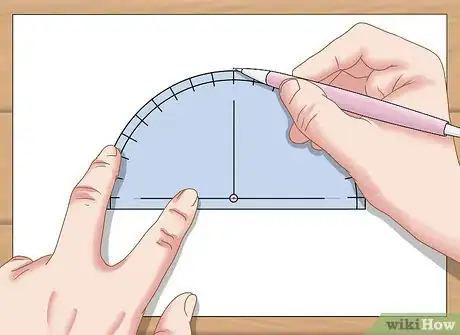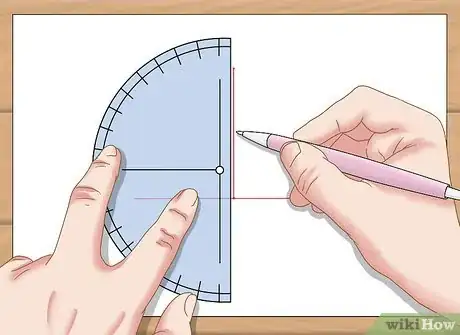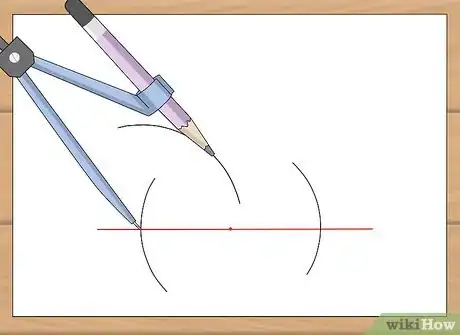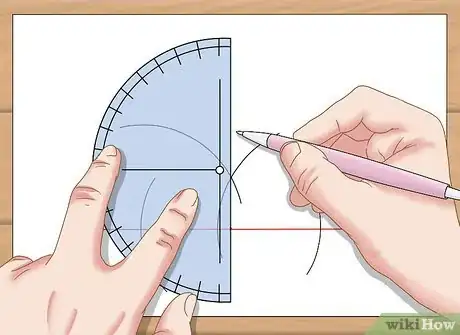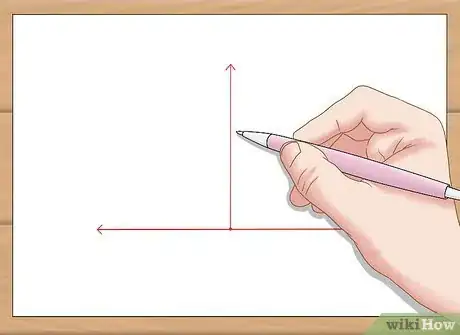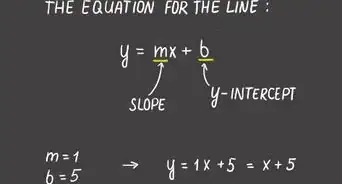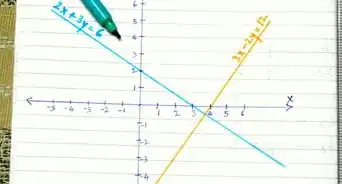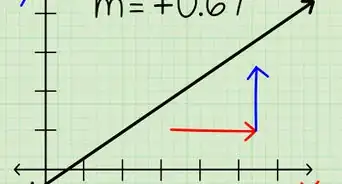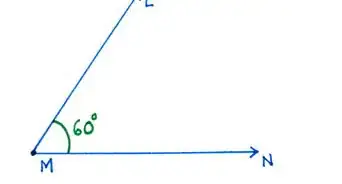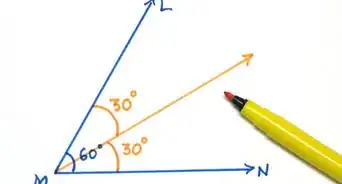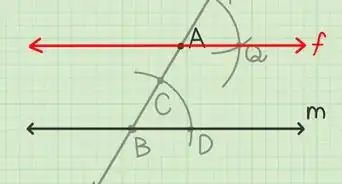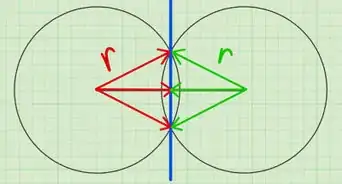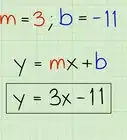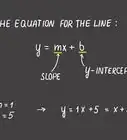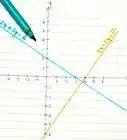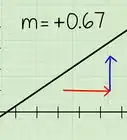X
This article was co-authored by wikiHow Staff. Our trained team of editors and researchers validate articles for accuracy and comprehensiveness. wikiHow's Content Management Team carefully monitors the work from our editorial staff to ensure that each article is backed by trusted research and meets our high quality standards.
This article has been viewed 99,560 times.
Learn more...
Perpendicular lines are lines that form right angles. These types of lines are used often in geometry, so it is important to know how to construct them. The simplest way to construct a perpendicular line is to use a protractor. However, you will often be asked to construct a perpendicular line using only a compass and straightedge.
Steps
Method 1
Method 1 of 2:
Using a Protractor
-
1Line up the given line and the protractor. Set the protractor’s origin hole over the line's given point. Align the protractor so that its base line sits exactly over the given line.
- The origin hole is the small hole at the bottom-center of the protractor.
- The base line is the line on the bottom of the protractor marking 180/0 degrees.
-
2Mark a point at the 90-degree line. This is the line measurement at the very top of the protractor. Two perpendicular lines form a 90-degree, or right, angle.[1] Thus, to draw a perpendicular line, you need to draw a 90-degree angle.Advertisement
-
3Connect the given point with the 90-degree mark. Use the straightedge of the protractor to ensure that the line is straight. This line is perpendicular to the original line, through the given point on the line.
Advertisement
Method 2
Method 2 of 2:
Using a Compass and Straight Edge
-
1Draw an arc on either side of the given point. To do this, place the compass tip on the given point on the line. Then, swing the compass, drawing two arcs on both sides of the given point. The arcs should intersect the line.[2] Mark and label the points where the arcs intersect the line.
- You can set the compass to any width for this step.
- For example, you might be given point A on a line. Use the compass to draw point P to the left, and point Q to the right.
-
2Increase the width of the compass. Place the compass tip on the new point to the left of the original point. Stretch the compass so that it reaches about halfway between the original point, and the new point on the right.[3]
- For example, place the compass tip on point P, and stretch the compass to a point about halfway between points A and Q.
-
3Draw an arc above the line. You could also draw the arc below the line. Keeping the compass tip on the left point, swing the compass, drawing an arc. Make sure the arc crosses over the original point.[4]
- For example, keep the compass tip on point P. Draw an arc above the line.
-
4Draw a second arc, intersecting the first. Do not change the width of the compass. Set the compass tip on the right point. Swing the compass, drawing an arc above the line that intersects the first arc.[5] Mark this intersection with another point.
- For example, place the compass tip on point Q. Draw an arc that intersects the first arc at point T.
-
5Connect the given point to the point where the arcs intersect. Use a straightedge to ensure the line is straight. The line you draw is perpendicular to the first line, through the given point on the line.[6]
- For example, draw a line connecting points A and T.
-
6Finish up with the construction.
Advertisement
Community Q&A
-
QuestionCan we draw the arc both above/below the line?
 DonaganTop AnswererYes. With either of the methods shown above, you may (but don't have to) draw similar arcs on both sides of the given line. An arc (or arcs) on just one side of the line is sufficient, but drawing them on both sides is a good way to verify the accuracy of the perpendicular line.
DonaganTop AnswererYes. With either of the methods shown above, you may (but don't have to) draw similar arcs on both sides of the given line. An arc (or arcs) on just one side of the line is sufficient, but drawing them on both sides is a good way to verify the accuracy of the perpendicular line. -
QuestionHow can I divide a straight line into 6 equal parts?
 DonaganTop AnswererAssuming no measuring tool or protractor, this can be done with a compass and straightedge. Label the line AB. From A draw another straight line at any acute angle from AB. Mark off six equal segments on this new line. Label the segments AC, CD, DE, EF, FG and GH. Draw a line from H to B. From line AH draw five lines to AB that are each parallel to HB. (Use a compass or protractor to make these lines parallel to HB.) These parallel lines will intersect AB so as to divide AB into six equal parts.
DonaganTop AnswererAssuming no measuring tool or protractor, this can be done with a compass and straightedge. Label the line AB. From A draw another straight line at any acute angle from AB. Mark off six equal segments on this new line. Label the segments AC, CD, DE, EF, FG and GH. Draw a line from H to B. From line AH draw five lines to AB that are each parallel to HB. (Use a compass or protractor to make these lines parallel to HB.) These parallel lines will intersect AB so as to divide AB into six equal parts. -
QuestionHow can you draw a perpendicular line a then make a line parallel to it?
 Community AnswerYou can follow the same steps, but begin with a different point on the line.
Community AnswerYou can follow the same steps, but begin with a different point on the line.
Advertisement
References
- ↑ http://www.mathgoodies.com/glossary/term.asp?term=perpendicular%20lines
- ↑ http://www.mathopenref.com/constperplinepoint.html
- ↑ https://www.mathsisfun.com/geometry/construct-perponline.html
- ↑ http://www.mathopenref.com/constperplinepoint.html
- ↑ https://www.mathsisfun.com/geometry/construct-perponline.html
- ↑ http://www.mathopenref.com/constperplinepoint.html
About This Article
Advertisement

